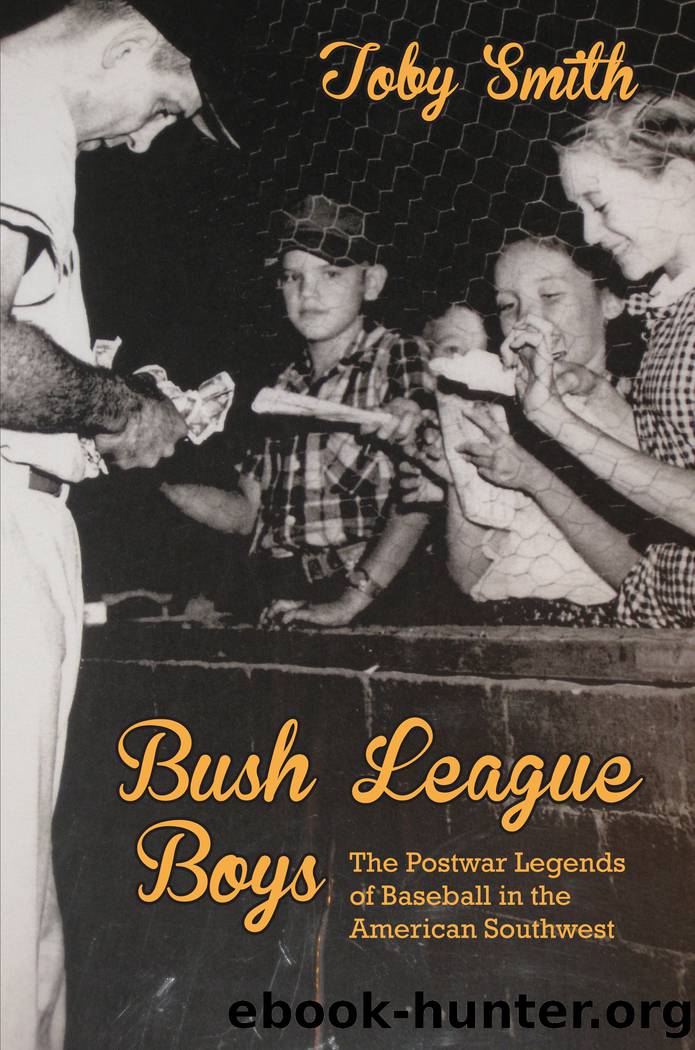Bush League Boys by Smith Toby;

Author:Smith, Toby;
Language: eng
Format: epub
Publisher: University of New Mexico Press
Published: 2014-08-15T00:00:00+00:00
More than anything, sports reporters during this period were âhomers,â which in large part explained their popularity. Building up the home team in print and holding an absolute loyalty to that task was appreciated by newspaper readers and demanded by many publishers. Columns slamming players or teams rarely were published.
Bern Gantner of the Clovis News-Journal bubbled over with praise in his column when the Clovis Pioneers showed up in 1955 dudded out in new uniforms. âThis yearâs Pioneers are a different bunch of players from those who have worn the livery of the Pioneers in the past,â Gantner wrote. âThese uniforms are the best that money can buy. Each costs more than half a century note, according to manager Grover Seitz. Fifty-two dollars to be exact.â To certify the quality of the uniforms, Gantner quoted Seitz: âThose suits didnât come out of a Cracker Jack box.â
Readers in the South Plains region of Texas always knew where Joe Kelly of the Lubbock Avalanche-Journal stood. No one root-rooted for the home team more than old Joe Kelly. In an August 1951 Between the Lines column, Kelly confronted one more mediocre season for the local nine, the Hubbers. âLubbock fans tonight have a chance to show their appreciation for the fine job the players have done this year,â he wrote. âTheyâre a swell bunch of guys and deserve every good thing they can be given. Theyâll need all the support they can get with the invading Lamesa Lobos. Go out and let the players know youâre for them.â
On the other hand, J. D. Kailer would let the home team have it in the Albuquerque Journal if he felt it appropriate. Though the Dukes in the early 1950s were losing money, the clubâs owner continued to count his nickels. âThrifty doesnât begin to describe him,â Kailer wrote.
Jerry Dorbin of the Carlsbad Current-Argus had entered journalism to write Great Literature. It was not unusual for Dorbin to turn out fine prose, even on deadline. After Gil Carter of the Carlsbad Potashers hit a home run farther than anyone at the time could imagine, Dorbin banged out this well-crafted lead for his game story: âTuesday night at eight-forty-five p.m., using home plate at Montgomery Field for a launching pad and without so much as a countdown, a six-foot, one inch, 208-pound outfielder became the first man in history to put a baseball in orbit.â
Many of the columnists of that period resorted to what became known as âthree-dot journalism.â Emptying a notebook filled with scraps and stringing them together, separated by ellipses, was a lot easier than writing a continuous narrative. Such a style is still used, but almost always at the very end of a reporterâs story, not throughout it.
Download
This site does not store any files on its server. We only index and link to content provided by other sites. Please contact the content providers to delete copyright contents if any and email us, we'll remove relevant links or contents immediately.
Machine Learning at Scale with H2O by Gregory Keys | David Whiting(3637)
Never by Ken Follett(3531)
Liar's Poker by Michael Lewis(3228)
The Ultimate Backcountry Survival Manual by Aram Von Benedikt; Editors of Outdoor Life;(3172)
Will by Will Smith(2581)
The Partner by John Grisham(2286)
Can't Hurt Me: Master Your Mind and Defy the Odds - Clean Edition by David Goggins(2004)
Friends, Lovers, and the Big Terrible Thing by Matthew Perry(1998)
Taste by Kris Bryant(1802)
HBR's 10 Must Reads 2022 by Harvard Business Review(1698)
A Short History of War by Jeremy Black(1671)
Never Finished: Unshackle Your Mind and Win the War Within by David Goggins(1557)
The Arm by Jeff Passan(1522)
515945210 by Unknown(1521)
The Dodgers by Schiavone Michael;(1477)
The Yogi Book by Yogi Berra(1426)
443319537 by Unknown(1395)
1942266391 (N) by Monte Francis(1372)
Road Games by Road Games(1371)
